Corkbeg
Houses within 10km of this house
Displaying 88 houses.
Houses within 10km of Corkbeg
Displaying 88 houses.
| House name | Description | |
|---|---|---|
| Fountainstown | Francis Hodder was leasing this property to George Hodder at the time of Griffith's Valuation, when it was valued at £24. In 1837 Lewis referred to Fountainstown as the seat of G. Hodder. Local sources indicate that this house originally belonged to the Roche family whose lands the Hodders were granted and that the oldest part of Fountainstown House was the original Roche property. In the 1940s the Irish Tourist Association Survey noted that it was listed in the Association's directory of hotels. Fountainstown is still extant and occupied. |

|
| Gortigrenane House | At the time of Griffith's Valuation, this house was being leased by Anthony Savage from the Staughton estate, when it was valued at £40. Lewis refers to it as the seat of Luke Shea in 1837. Thomas A. Staughton owned a second property in this townland [W777575], valued at £10 and leased to David Drinan. Gortigrenane had originally been a Daunt property, which came to Staughton through marriage with Mary Daunt, of Owlpen, Gloucestershire. It is believed to have been remodelled in 1817. See www.owlpen.com. The house was destroyed during the War of Independence. In 1942 the Irish Tourist Association Survey described it as formerly the residence of L. Shea, "a noted smuggler" and then in the possession of the Kingstons. It is now a ruin. |
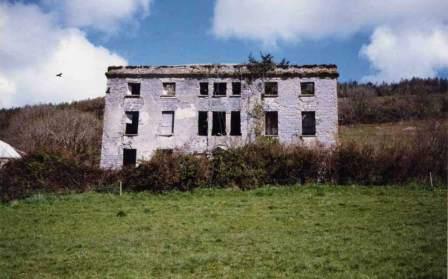
|
| Ringabella | Samuel Hodder held this property in fee at the time of Griffith's Valuation, when it was valued at £25. Lewis refers to it as the seat of S.A. Austin in 1837. In 1942 the Irish Tourist Association Survey noted that had been a residence of the Austins but was then owned by the McCarthy family. Ringabella is still extant and occupied. | |
| Ballybricken House | Described by Lewis in 1837 as "the elegant mansion and demesne of D.Connor". It was held in fee by him at the time of Griffith's Valuation when it was valued at £64. The residence of Captain Denis Connor in 1894. In 1943 the Irish Tourist Association Survey mentions it as the residence of J.E. Bird, the walls built in 1820 but the interior having been restored following a fire in 1910. The Survey also notes that it was used as a base by the American navy during the first World War. The site is now covered by industrial premises. | |
| Prospect Villa | Thomas Burke was leasing Prospect Villa from Mary and Catherine Rogers at the time of Griffith's Valuation, when it was valued at £60. Lewis refers to it as the seat of Lt.Col. Burke in 1837. The house was included in the sale of the Rogers estate in the Landed Estates Court in February 1862. In 1943 the Irish Tourist Association Survey noted Prospect Villa as the residence of G. Hosford and outlined Burke's association with the house mentioning that he kept a racing stable there. The house is no longer extant and a factory has been constructed in this area. | |
| Castlewarren | Robert Warren was leasing this property from Mary and Catherine Rogers at the time of Griffith's Valuation, when it was valued at £35. In 1837 Lewis referred to it as a "spacious mansion erected in 1796, the seat of R. Warren". Townsend refers to it as the seat of Thomas Warren "whose style of farming is conducted on the best principles of modern art". It was included in the sale of Warren's estate in October 1850. Now a ruin. | |
| Rock Cottage (Barnahely) | William Warren was leasing this property to Richard Foott at the time of Griffith's Valuation, when it was valued at £11 5s. A house is still extant at the site. | |
| Fahalea | Thomas Daunt held this property in fee at the time of Griffith's Valuation, when it was valued at £10. Extensive farm buildings exist at the site now. | |
| Ballynametagh | At the time of Griffith's Valuation, John Kingston was leasing this house to Daniel Coates, when it was valued at £9. A modern house and farm occupy this site now. | |
| Waterpark | This was a Lavallin home in the 18th century. Robert Atkins leased this property from the representatives of Thomas Dorman/Dormand at the time of Griffith's Valuation. It was valued at £48. | |
| Mount Rivers (Carrigaline) | Michael Roberts was leasing Mount Rivers from the representatives of Daniel Morrison at the time of Griffith's Valuation, when it was valued at £45+. The sale rental of 1863 records Michael Hodder Joseph Roberts as the tenant of Mount Rivers. The house is still extent and the National Inventory of Architectural Heritage states that it is still owned by the Roberts family. |

|
| Commeen | Thomas Hayes was leasing this property to Richard Hayes at the time of Griffith's Valuation, when it was valued at £8, on a holding of 230 acres. On the 25-inch Ordnance Survey map of the 1890s it is labelled Commeen Kennels. Farm buildings still exist at the site. | |
| Coolmore | Held in fee by Reverend Edward H. Newenham at the time of Griffith's Valuation, when it was valued at £100. He was leasing a smaller house, valued at £8, to John Donegan in the same townland. Noted by Leet as the residence of W.W. Newenham in 1814. Valued at £64 in 1906 when it was the residence of Major William W. Newenham. The Irish Tourist Association Survey also noted it as belonging to the Newenhams in 1943. It is still extant but in poor repair. |
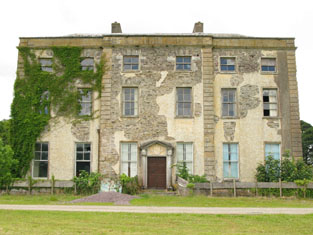
|
| Shanbally Cottage (Carrigaline) | Thomas Burke was leasing this property to Joseph Beaumont at the time of Griffith's Valuation. It was valued at £34 and included a mill. The latter, known as Rathanallig Mills (W751651), is described as "in ruins" on the 25-inch Ordnance Survey Map of the 1890s while the house is diminished in size and has since disappeared. There are still buildings on the mill site. | |
| Raffeen House | Robert Hedges White held this property in fee at the time of Griffith's Valuation, when it was valued at £42. It was the home of his wife's family, Charlotte Mary Dorman. In 1837 Lewis referred to it as the seat of T. Dorman. The property is still extant. |

|
| Raffeen Cottage | Robert White was leasing this property to Sarah Phillips at the time of Griffith's Valuation when it was valued at £12 5s. It appears on the 25-inch Ordnance Survey map as Raffeen Cottages, indicating the presence of more than one dwelling. The buildings are still extant. | |
| Raffeen House [Lower] | William Drinan was leasing this property from the White estate at the time of Griffith's Valuation, when it was valued at £13 10s. The site is now occupied by industrial premises. | |
| Ardmore House | Richard Roberts held this property in fee at the time of Griffith's Valuation, when it was valued at £55. Lewis refers to is as the seat of J. Roberts in 1837. In 1943 the Irish Tourist Association Survey mentions it as the birthplace of Lieutenant Richard Roberts, Master of the ship, Sirius, the first steamship to cross the Atlantic. Ardmore is still extant and occupied. | |
| Aghamarta Castle | This property was held in fee by the representatives of Carew O'Grady at the time of Griffith's Valuation, when it was valued at £22. Lewis noted it as the seat of Carew O'Grady in 1837. Local sources suggest that he had purchased it, c.1824, from the Pomeroy family, who had purchased it from the Earl of Shannon in the later seventeenth century. The original castle was replaced by the existing house in the 1830s. The property is now a farm and cookery school. See www.thompsonsfarmshop.com |
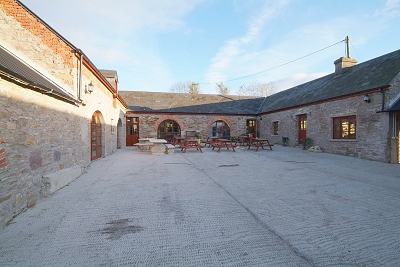
|
| Crosshaven House | Thomas Hayes held this property in fee at the time of Griffith's Valuation, when it was valued at £44. Lewis refers to it as the seat of T. Hayes in 1837. Local sources suggest it was built in the eighteenth century replacing an earlier house. It remainded in the ownership of the Hayes family until the early 1970s. The house is still extant and occupied and sometimes open to the public. |
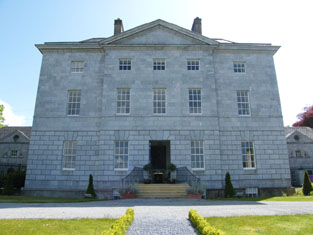
|
| Point House (Crosshaven) | Edward Sisk was leasing this house from the Puxley estate at the time of Griffith's Valuation, when it was valued at £10 10s.The house at the site is known as Point House and the National Inventory of Architectural Heritage suggests it was built in the mid-eighteenth century. |

|
| Hoddersfield | Lewis refers to Hoddersfield as the seat of Col. Hodder in 1837 and held in fee by William H. Hodder in 1850. The house was then valued at £95. In 1894 Slater referred to it as the seat of William Hodder. In the 1940s the Irish Tourist Association noted that it was the residence of B Nicholson, who had bought the property from the Hodders and that the Library and other Hodder materials remained intact at the house. Hoddersfield is now a roofless ruin. |

|
| Myrtleville Cottage | Ó Murchadha states that Myrtleville Cottage was built by Sir Nicholas Trant in the early nineteenth century and was later sold by him to Joseph Cummins. At the time of Griffith's Valuation, this property was unoccupied but owned by several parties including Cummins as well as the Daunt and Puxley estates. It was then valued at £11. It is still extant and has sometimes operated as a bar and restaurant. |

|
| Myrtleville House | Lewis refers to Myrtleville House as the seat of Dr. Shea. This was Dr William Augustine Shea or O'Shea, brother of Luke Shea of Gortigrenane. By 1850 it was being leased by James Fegan from the Puxley estate among others and was valued at £25. Ó Murchadha notes that it had earlier been owned by the Trant family and had a suceession of owners since including several periods of occupation by members of the Daunt family. It is still extant. |

|
| Fota House | Originally built as a hunting lodge for the Smith Barrys in the 18th century and enlarged in the 1820s to the design of Sir Richard Morrison with further 19th century additions. Valued at £89 and held by James H.S. Barry in fee at the time of Griffith's Valuation. Occupied by Lord Barrymore in 1906 and valued at £160. Inherited by Major and the Honourable Mrs Bell. The Irish Tourist Association survey provides details of some of the paintings in the house and exotic plants in the gardens. Bence Jones writes that Fota was sold to University College, Cork in 1975 following the death of Mrs Bell. It is now in the care of the Irish Heritage Trust and after restoration was reopened to the public in 2009. http://www.fotahouse.com/display.php |

|
| Seamount House (Carrigaline) | Louisa Penrose, with several others, was leasing this property to James French at the time of Griffith's Valuation, when it was valued at £12. Henry Smith was leasing a property [W785625] valued at £10 from the same estate, also in Curraghbinny townland. In 1860, over 600 acres owned by members of the Fitzgerald family and others were offered for sale in the Landed Estates Court. The sale included Seamount House, in the possession of Henry Smith. | |
| Hilltown House (Carrigaline) | Hilltown House was leased by Thomas Busteed from Anne Cook at the time of Griffith's Valuation, when it was valued at £8. It is labelled as Hilltown House on both the 6-inch and 25-inch Ordnance Survey maps. | |
| Trabolgan | Home of the Roche family for over three centuries. Held by Edmund Burke Roche in the mid 19th century and valued at £100. In 1912 acquired by the Clarke family, owners of the tobacco company in Bristol, manufacturers of Players cigarettes. Owned by the Clarkes until the 1940s when purchased by the Land Commission. The Irish Tourist Association survey noted that it was for sale in 1942. The house was demolished in 1982 and the demesne is now an activity holiday centre, see http://www.trabolgan.com/Home.aspx |

|
| Tullagreen | Occupied by Robert Martin in 1814 and by Hughes Martin in 1837. The house was recorded as unoccupied at the time of Griffith's Valuation. Hughes Martin was the immediate lessor and the house was valued at £19+. |

|
| Rockville | The Barrys were inhabiting Rockville by the mid 18th century. William Barry was resident in 1814 and his seventh son Thomas Barry in 1837. In the early 1850s Garret Barry was occupying this house which he held from Sir William Clarke. It was valued at £15.15 shillings. | |
| Rossmore | Rossmore was a Coppinger home in the 19th century, the residence of Thomas Coppinger in 1814 and 1837. Thomas Francis Coppinger is recorded as the occupier at the time of Griffith's Valuation when the property, valued at £19, was held from Sir William Clarke. | |
| Barryscourt | Originally a seat of the Barry family, Earls of Barrymore, it had become a Coppinger home by the mid 18th century. Wilson refers to it as the seat of Mr. Coppinger in 1786 and also notes "the castle of Barry's Court". It was the residence of William Coppinger in 1814 and in the early 1850s, when it was held from Sir William Clarke and valued at £22. Following William's death in 1862 this property passed to his nephew Morgan John O'Connell. Bence Jones records it as a ruin but the original medieval castle has been refurbished and is now open to the public. In the 1940s the Irish Tourist Association survey included a description of both buildings. | |
| Barry's Lodge | Occupied by D. Barry in 1837 and by Henry Barry in the early 1850s. He held the property valued at £28 from Samuel Reeves. | |
| Ballyvodock | Thomas Wigmore occupied this house in the mid 19th century. He held it from the representatives of Viscount Midleton and it was valued at £9+. | |
| Ahanesk | A house on the shore of Cork Harbour occupied by William Oliver Jackson at the time of Griffith's Valuation and held by him in fee. It was valued at £24. In 1906 a mansion house in the townland of Ballyvodock East was valued at £98. The house passed by marriage to the Sadlier Jackson family and in the mid 20th century became the home of the Lomers. |
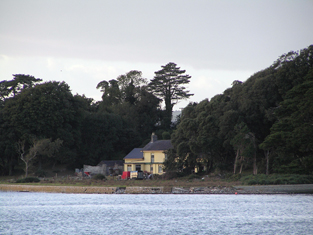
|
| Ballyvodock House | James Barry was living at Ballyvodig House, Middleton, in 1814. In the mid 19th century William Kelleher was the occupier. He held the property from William Oliver Jackson and the buildings were valued at £11. A house and large farm are still extant at the site. | |
| Ballintubbrid House | Ballintobrid, Middleton, was the home of William Weekes in 1814. By 1837 it was the home of the Heard family and occupied and held by Edward Heard in fee at the time of Griffith's Valuation. The house was valued at £13. The original house is not extant. | |
| Ballyannan | The Brodricks first occupied Ballyannan Castle, a fortified house in the townland of that name, which was in ruins by 1837. In 1786 Wilson refers to Ballyanan"belonging to Lord Viscount Midleton". On the first Ordnance Survey map there is a building named Ballyannan House (W867 715) right on the shore close to the castle and there is a house in the townland of Garryduff named Ballyannan. Ballyannan was occupied by Roger Adams in 1814 and by J. Adams in 1837. At the time of Griffith's Valuation the representatives of Viscount Midleton occupied a house and offices valued at £19 in the townland of Garryduff. The house in the townland of Ballyannan was valued at £9.10 shillings and was occupied by Daniel Twomey and held from the Viscount. | |
| Marino | The present house was built on the foundations of an earlier house which was burnt in the 1860s. Wilson refers to this earlier house on Great Island as the seat of Savage French in 1786. Marine remained the home of a branch of the French family and sold by Colonel Stuart French in the early 1970s. The National Inventory of Architectural Heritage entry states that this house was previously the home of the mathematician Philip Ronayne. Valued at £32 in the early 1850s it was occupied by Thomas G. French who held the property from Thomas R. Sarsfield. Knight writes that Thomas Sarsfield of Doughcloyne leased the lands of Ronayne's Grove, otherwise Hodnet's Wood, otherwise Marino to Savage French in 1755. Thomas G. French is also recorded as the occupier in 1814 and 1837. |

|
| Carrigrenan | Occupied by J. M. Ashlin (father of the architect George Ashlin) in 1837 and by the Reverend Robert Bury in the early 1850s. He held the house valued at £37 from Warren H. R. Jackson. The home of the Sullivans in the 20th century. | |
| Ashgrove | A branch of the Rogers family was located at Ashgrove in the early 18th century. Described by Bence Jones as a late Georgian house built for Councillor Franklin by Abraham Hargrave and now a ruin. In 1810 Townsend referred to the new house of Richard Frankland "built in the best modern style". It was occupied in 1814 by Mrs Franklan and in 1837 by R. Frankland. Richard Frankland held the property in fee at the time of Griffith's Valuation when the buildings were valued at £32. |

|
| Bennett's Court | The Bennetts were resident at Ballymore from the 18th century but this house dates from about the 1840s. At the time of Griffith's Valuation it was the residence of Joseph H. Bennett who held it in fee. The buildings were valued at £41. Owned by a religious order in the 20th century and now in use as a medical clinic. |

|
| The Priory | A house valuled at £17+ at the time of Griffith's Valuation and held by the Reverend Francis Newport from Joseph H. Bennett. The Reverend Newport's daughter married J. H. Bennett's nephew in 1865 and they eventually inherited Bennett's Court. |

|
| Ballymore House | The Hare family, Earls of Listowel, also held land in the townland of Ballymore in the 19th century. In 1814 the proprietor of Ballymore was the Honourable Mr Hare. In 1837 J.H. Bennett was resident at Ballymore House. This house appears to have been in the possession of the Honourable Robert Hare at the time of Griffith's Valuation when it was held from Joseph H. Bennett and valued at £15+. Robert Hare was a younger brother of the 2nd Earl of Listowel and married in 1840 Louisa French of Marino. Their son Robert Dillon lived at Ballymore. In 1906 John C. Bennett is given as the occupier and the mansion house was valued at £65. Bence Jones writes that post 1950 owners include the O'Donovans and Hecketts. |
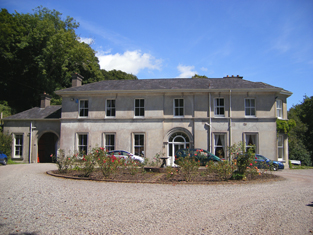
|
| Belgrove | A house possibly inherited by the Bagwells through marriage with the Harpers. The residence of J. Travers in 1814 and of the Reverend G. Gumbleton in 1837 and in the early 1850s. The Reverend Gumbleton held the property from John Bagwell and it was valued at £36. Bence Jones writes that William Gumbleton, son of the Reverend, lived in this house under 1911. The house was demolished in the mid 20th century and a new building erected. | |
| East Grove | Bence Jones writes that this early 19th century house was built by Dorcas Bousfield, daughter of William Bagwell and his wife Jane Harper. After her death it was inherited by the Bagwells and remained in their possession until the mid 20th century. In 1837 John Bagwell is recorded as the proprietor of East Grove and also in the early 1850s, when the property was valued at £40 and held from the representatives of Viscount Midleton. In 1942 the Irish Tourist Association Survey noted that it was the residence of Major Bagwell and the adjacent grounds contained the remains of buildings thought to be "the now-unknown castle of Ballinakilla". 20th century owners included Lorretta Brennan Glucksman, and the Kelly family, musicians. In recent years it has been offered for sale. |

|
| Cuskinny | A French home from the early 19th century, occupied by Savage French in 1814 and by his son Savage T.W. French in 1837 and in the early 1850s. The house was then valued at £32 and held from Bartholomew Verling and Thomas R. Sarsfield. IN 1894 Slater noted it as the seat of S. French. This property was still in the possession of the descendants of the French family in the 1970s. |

|
| Hadwell Lodge | Lewis records the Reverend Dr Austen as resident at Hadwell in 1837 [this may have been the nearby glebe house] and J. Penrose at Hadwell Lodge. In the early 1850s the Reverend Robert Austin occupied Hadwell Lodge. It was valued at £50 and held from William Gearin. By the 1890s this property had become known as Hadwell House. It is described as "in ruins" on the 1940 edition Ordnance Survey map. | |
| Aghada | J. Roche occupied this house in 1837. He built Aghada House and had a daughter who married [Henry] O'Brien of Whitepoint and they had a daughter who married her cousin William Roche. William Fitzgibbon was resident at Aghada House at the time of Griffith's Valuation when the house was valued at £35 and held from Henry O'Brien. It was the seat of William de Wilton R. Thackwell in 1894. http://www.archive.org/stream/barrymorerecords00barr/barrymorerecords00barr_djvu.txts | |
| Whitegate House | In 1786 Wilson refers to Whitegate as the seat of Thomas Travers. It was the home of Mrs Gertrude Fitzgerald (nee Blakeney Lyon), wife of Robert Uniacke Fitzgerald, in 1837 and at the time of Griffith's Valutaion when it was valued at £25 and held from Robert U. P. Fitzgerald. The property passed in the mid 1850s to the niece of R.U. Fitzgerald, Anne Penrose, who was married to Thomas Stewart. Still extant and occupied. |
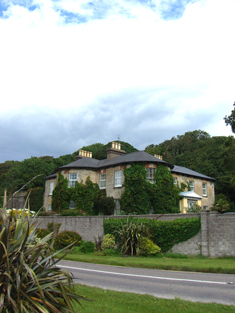
|
| Maryland House | The residence of Joseph Haynes in 1837 and the early 1850s, held by him from William Player at the time of Griffith's Valuation and valued at £20. A cornmill was located closeby. Maryland is no longer extant. | |
| Rose Hill | At the time of Griffith's Valuation Alexander McNab held Rose Hill House valued at £15 with 120 acres from the Marquess of Thomond. The National Inventory of Architectural Heritage shows a house at this location dating from the 1890s. |
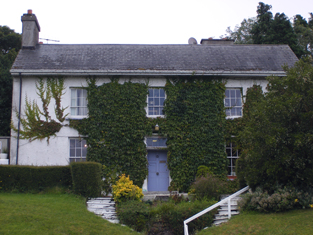
|
| Jamesbrook Hall | The home of the Adams family, occupied by Michael Go[o]ld Adams in 1814 and by Richard W. G. Adams in 1837 and in the early 1850s when the house was valued at £60 and held from the Marquess of Thomond. Occupied by William R. G. Adams in 1906. Recently renovated and restored. |

|
| Rostellan | Seat of the Marquess of Thomond, occupied by him in in 1786 (Lord Inchiquin. It was at £79 in the early 1850s. Bought by Dr T.A. Wise after the Marquess's death in 1855, a lithograph of the house is included in the sale rental. Subsequently purchased by Sir John Pope Hennessy and mentioned by Slater as the residence of Lady Pope Hennessy in 1894. Occupied by Charles J. Engledew and valued at £112 in 1906. The Irish Tourist Association survey noted in the early 1940s that the roof and fittings had recently been removed and the land taken over by the Land Commission. No trace of the house remains now. |

|
| Mosestown | In 1786 Wilson notes a house on the left of Whitegate as the seat of Charles Allen. This may refer to the house labelled "Mosestown House" on the 1st edition Ordnance Survey map. At the time of Griffith's Valuation it was occupied by Edmund Roche, son of Francis Roche of Rochemount. The house was valued at £21 and held from Edmond B. Roche. Edmund was a distinguished soldier rising to the rank of Major General and married Anna Matilda, daughter of the Reverend Austen, of Hadwell Lodge. In 1894 Slater recorded a house known as Ballymonis as the seat of General Edmund Roche. Mosestown is labelled Ballymonis on the 25-inch Ordnance Survey map of the 1890s. It is no longer extant. | |
| Rochemount | The residence of a junior branch of the Roche family in the 19th century. Occupied by Francis Roche in 1814 and by John Webb Roche in 1837 and the early 1850s when the buildings were valued at £30. He held the property in fee. In 1894 Slater notes Rochemount as the seat of Francis W.A. Roche. There are still buildings extant at this site. | |
| Kilboy/Keil Bui | Marked as Keil Bui in the townland of Kilboy on the first Ordnance Survey map, occupied by Lewis Gibson in 1814 and by John Gibson in the early 1850s who held the property in fee. The buildings were valued at £25. This house is described as a former deanery in the National Inventory of Architectural Heritage and is now in use as a private residence. |

|
| Kilcrone | An early 18th century house, the home of the Hannings in the first half of the 19th century, held by him from Mountifort Longfield at the time of Griffith's Valuation when valued at £30. The sale rental of 1858 records William G. Fitzgerald as the occupant of this house on a temporary basis. This house is occupied and well maintained. |
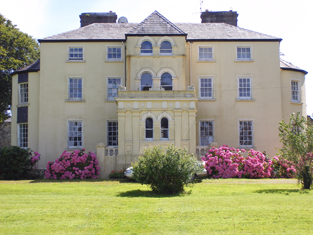
|
| Lindsey Cottage | Marked on the first Ordnance Survey map as Lindsey Cottage. At the time of Griffith's Valuation it was occupied by John Litton who held it from the Bishop of Cork, Cloyne and Ross. The buildings were valued at £20. | |
| Castle Mary | An 18th century house, remodelled as a castle in the 19th century, home of a branch of the Longfield family. In 1786 Wilson give a description of the house including that "the west front of this mansion presents a view of Cork Harbour". Valued at £85 in the mid 19th century and held by Mountifort Longfield in fee. Bence Jones writes that this house was burnt in the early 1920s and is now a ruin. A new house was constructed from the old stable courtyard and the family continued to live there for periods of time during the 20th century until Castle Mary was acquired by the Hurley family in 1978. |
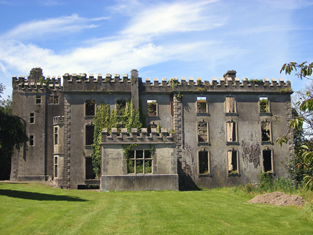
|
| Rathcoursey House (East) | At the time of Griffith's Valuation a house in Rathcoursey East valued at £18 was held by Richard Lyons from the Provost and Fellows of Trinity College, Dublin. This house is still a residence. |

|
| Rathcoursey House (West) | Home of the Smith family in the 18th and 19th centuries. John Tynte Smyth lived here in the 1770s. Occupied by John Smith in 1814 and John J. Smyth in the early 1850s. The house was valued at £35 and held from the Marquess of Thomond with 214 acres. It is now run as a guest house. |

|
| Ballynacorra | An 18th century house, occupied by John Garde in 1814 and by Thomas Garde at the time of Griffith's Valuation, who held the building valued at £40 from the Earl of Shannon. Still in use as a residence. | |
| Rockview (Inch) | In 1837 Lewis refers to the "very pretty residence of Mr Fitzgerald" proprietor of the extensive limestone quarries at Carrigacrump. The house was named Rockview on the first Ordnance Survey map. Teresa Fitzgerald was the occupier in the early 1850s holding the property from Colonel William H.M. Hodder, the buildings were valued at £15. Teresa Fitzgerald (nee Coppinger of Rosmore) married James Fitzgerald and they had a son Maurice and daughters Teresa, Mary etc see ''The Barrys of County Cork''. Margaret Fitzgerald of Carrigacrump owned 83 acres in the 1870s. Her estate at Rockview was advertised for sale a number of time in the mid 1870s. There is still an extant house at the site. | |
| Violet Hill | Occupied by Jonas Smyth at the time of Griffith's Valuation and held by him from Henry Cornelius. The buildings were valued at £12. This house is still extant and occupied. |
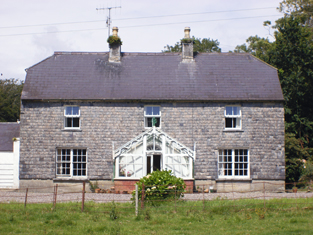
|
| Rose Hill | Occupied by William Rumly in 1814 and Lewis records T.H. Rumbley residing at Ballinacorra Lodge in 1837. Mountiford Longfield was the occupier in the early 1850s. Held by him in fee and valued at £15. This house is no longer occupied. |
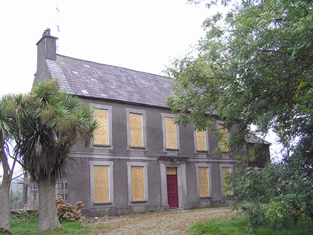
|
| Loughatalia | A house valued at £20 was occupied by William Humphreys at Loughatalia in the mid 19th century. He held the property with 34 acres from Henry Garde. This house now functions as a guest house known as Lochcarrig. |
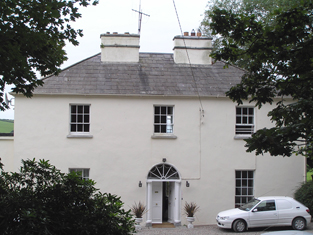
|
| Woodview | A house marked on the first Ordnance Survey map and occupied in 1837 by the Reverend J.P. Lawless. Valued at £18 at the time of Griffith's Valuation, occupied by the Reverend John L. Pyne and held from Mountifort Longfield. The location appears to be occupied by farm buildings now. | |
| Berry Hill | A house occupied by George Scott at the time of Griffith's Valuation, held from James Morrough and valued at £14. The home of Patrick Ronayne in the 1870s. This house is still a residence. |

|
| Ballynoe House | A house occupied by Abraham Hargreave in 1837 and at the time of Griffith's Valuation, held from James H.S. Barry and valued at £14.15 shillings. Abraham Hargrave owned 36 acres at Ballynoe in the 1870s. Later owned by the Murphy family. This house is still extant and occupied. |

|
| Kilboy | Francis Rowland was resident in 1837 and at the time of Griffith's Valuation, when the house was valued at £35 and held from Wallis Adams. It is now a ruin. | |
| Monkstown Castle | Built by a Mrs Archdeacon in the 17th century, Monkstown Castle was the home of the Shaw family in the 19th century and held from the de Vesci family. In the early 1850s Robert Bernard Shaw was resident and the buildings were valued at £54. In the possession of the Monkstown Golf Club for much of the 20th century, Further information on the building's construction is available at https://www.logainm.ie/ga/9588. |
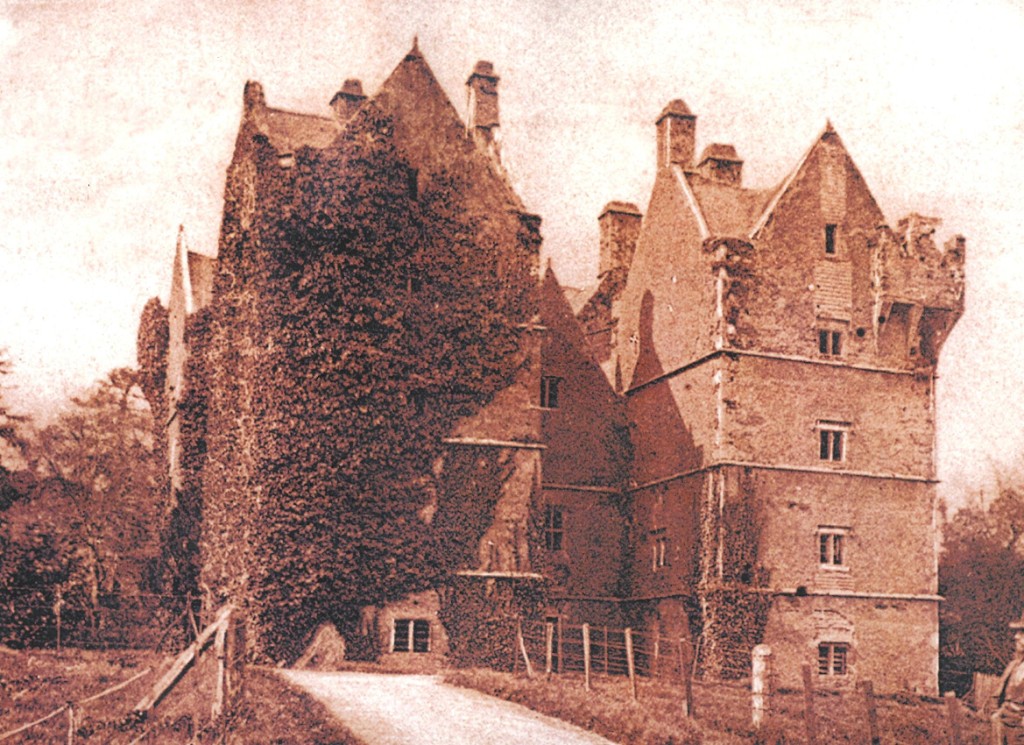
|
| Waterview (Passage West) | Leased by Richard Neville Parker from Lord deVesci's estate at the time of Griffith's Valuation when it was valued at £76. Waterview was offered for sale in the Landed Estates Court by Parker's widow, Hannah Maria, in September 1874. Waterview is still in use as a residence. | |
| Bellevue (Passage West) | In 1850, Nicholas Parker was leasing this property from the deVesci estate when it was valued at £33 10s. It is shown on the 25-inch Ordnance Survey map of the 1890s in a much enlarged form but was subsequently demolished to make way for the terrace of houses which now occupies the site. | |
| Ring View | Ring View was being leased by Robert Baily from the deVesci estate at the time of Griffith's Valuation, when it was valued at £18 10s. A house is still extant at the site. | |
| Rock Cottage (Passage West) | Catherine Parker was leasing this property from Thomas Boland in 1850 when it was valued at £36 10s. A house is still extant at the site. | |
| Lackaroe House | In 1850, Catherine Anne Parker was leasing this property to Cornelius Hawkes when it was valued at £21. A house still exists at this site. | |
| Rock Ville (Passage West) | Mrs. Anne Taylor was leasing Rock Ville from the Parker estate at the time of Griffith's Valuation, when it was valued at almost £25. Lewis refers to it as the seat of J. Taylor in 1837. It is still extant and occupied. |

|
| Rockenham | In 1850 Thomas Parsons Boland was leasing this house to Noble Johnson, when it was valued at £100. Lewis refers to it as Johnson's seat in 1837. The National Inventory of Architectural Heritage suggests it was built by the Johnsons in the 1820s. It is still extant and occupied. |
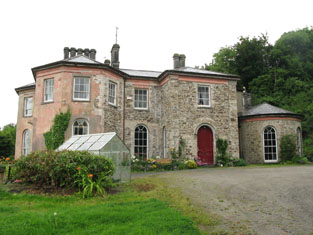
|
| Pembroke | The seat of Thomas Parsons Boland in 1837. Held in fee by him at the time of Griffith's Valuation, when it was valued at £48. Pembroke, together with many other of his houses, was included in the Sale Notice of Boland's estate in November 1859. It was offered for sale again in May 1868 when the house was noted as having "lofty and spacious rooms". In 1786 Wilson refers to Pembroke Town as the seat of Mr. Boland. In 1943 the Irish Tourist Association Survey noted that the Duke of Wellington was supposed to have stayed at Pembroke prior to embarking for the Peninsular wars. The house is no longer extant and a housing development has been built on the site. | |
| Horsehead | In 1850, Horsehead was being leased by James Craig from William Lane and was valued at £60. In November 1859 it was offered for sale as part of the Boland estate. Lewis refers to it as the seat of S. Lane in 1837, "an elegent mansion in the Tudor style". In 1943 the Irish Tourist Association Survey noted that the horses of the Duke of Wellington's cavalry had grazed on the front lawn at Horsehead prior to embarking for Europe. It is still extant and occupied. It was offered for sale in 2024. |
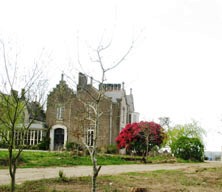
|
| Horsehead Cottage | Held from Thomas Boland's estate by Samuel Abbott in 1850 when it was valued at £38 10s. It was included in the sale of the estate in November 1859. It is no longer extant. | |
| Parkgarriff | This house was the home of at least two generations of David Cagneys in the 19th century. The house was valued at £40 at the time of Griffith's Valuation and held by David Cagney from Lord de Vesci. The Cagneys were still resident in the 1870s. The house no longer exists and the site is located on the edge of the Monkstown Golf Club. | |
| Seamount House (Carrigaline) | At the time of Griffith's Valuation, this property was leased by James French from the Penrose estate when it was valued at £12. The property is labelled Seamount House on the 25-inch Ordnance Survey Map of the 1890s. There is still an extant house at this site. | |
| Curraghbinny | In 1850 Henry Smith was leasing this property from the estate of Louisa Penrose and others, when it was valued at £10. It is not shown on the 25-inch map of the 1890s. | |
| Ballydulea | A house occupied by Edmond Bourke in the mid 19th century, held from Anne Payne, Mrs Cummins and the Reverend Fleming and valued at £14.10 shillings. In 1896 the encumbrances on land at Ballydulea was being finalised. The vendor was the Reverend Joseph King Cummin, see The Irish Law Times and Solicitors' Journal Vol XXX (1896). |
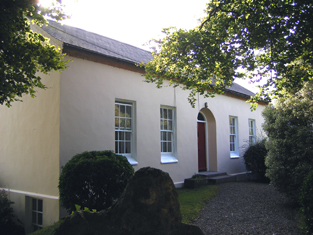
|
| Green Mount (Passage West) | Robert Hodgson was leasing Greenmount from the Boland estate at the time of Griffith's Valuation, when it was valued at £19. It is still extant and occupied. |
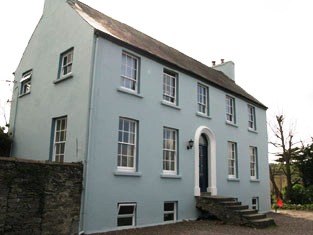
|
| Mansfield (Passage West) | At the time of Griffith's Valuation, William Browne was leasing this property from the Boland estate, when it was valued at £56. It is still extant. |

